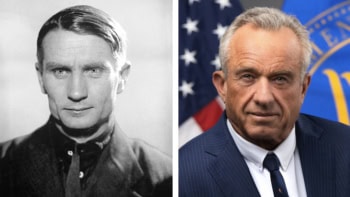
A statement submitted by the Institute of Physics (IOP) to a parliamentary inquiry on climate change continues to draw criticism, with one senior physicist saying that it is “not worthy” of the organization. Others have complained that the statement appears to play into the hands of climate “sceptics”, as it criticizes scientists for withholding climate data when requested using the UK’s Freedom of Information Act. The IOP, which owns the company that publishes physicsworld.com, has responded by making it clear that it believes in man-made climate change and that its submission was criticizing instead the practices of the climate scientists at the centre of the inquiry.
The IOP’s submission was sent last month to a House of Commons Science and Technology Committee inquiry into the disclosure of climate data from the Climatic Research Unit (CRU) at the University of East Anglia in the UK. The inquiry is investigating the alleged hacking of CRU servers, which resulted in hundreds of private e-mails between researchers over the last 14 years being disclosed online last November. The inquiry solicited responses about what possible implications the e-mail disclosures might have for the integrity of scientific research and whether the scope of a separate independent inquiry – led by Muir Russell, a former vice-chancellor of the University of Glasgow – into the CRU’s practices is adequate.
Some of the e-mails reveal that CRU director Phil Jones, who has since stepped down from the post until the Russell review is published, withheld data from being released even after freedom-of-information requests. One particular e-mail sent by Jones on 16 November 1999 caused a media furore when it was revealed that he wrote “I’ve just completed Mike’s Nature trick of adding in the real temps to each series for the last 20 years and from 1961 for Keith’s to hide the decline.”
The [IOP’s] evidence is both misinformed and misguided Stefan Rahmstorf, Potsdam University
“Mike’s Nature trick” refers to a paper published in the journal Nature (392 779) in 1998 by Michael Mann from Pennsylvania State University, Raymond Bradley from the University of Massachusetts Amherst and Malcolm Hughes of the University of Arizona. In the paper, the researchers sought to estimate how the mean temperature of the northern hemisphere has changed over the past millennium by combining various “proxy” temperature records, such as the diameter of tree rings and the presence of hydrogen and oxygen isotopes in ice cores, with thermometer temperature measurements.
[We] focused on the need to maintain the integrity, openness and unbiased nature of the scientific process IOP statement
The resulting “hockey stick” plot shows a relatively flat, but fluctuating, temperature for more than 900 years, from A D 1000 onwards (the shaft of the hockey stick) that then rises suddenly in the past 100 years (the blade). The hockey-stick graph, which is widely considered as a valid result in the climate-research community, was later included into the third assessment report by the United Nations Intergovernmental Panel on Climate Change (IPCC) in 2001.
The “trick”, as mentioned by Jones in one of his e-mails to Mann, Bradley and Hughes, is a statistical method that is widely accepted in the climate community and is applied to proxy measurements in the years since 1960. It deals with the problem that some tree rings in certain parts of the world have stopped getting bigger since that time, when they ought to have been increasing in size if the world is warming. According to physicist Rasmus Benestad from the Norwegian Meteorological Institute and a blogger for realclimate.org, Jones’ reference to “hiding the decline” could have involved removing some tree-ring proxy data from the analysis after 1960 to produce a curve that agrees better with the evidence for global warming.
However, sceptics of man-made climate change jumped on the phrase used by Jones saying that he and the CRU were hiding temperature decreases in their data and using certain sections of the full data set that most support the conclusions they want to report.
Under fire
The IOP’s submission to the inquiry, which was sent on 10 February following approval by the Institute’s Science Board, says that the disclosed e-mails from the CRU threaten the “integrity of scientific research in this field”. The submission argues that the integrity of the scientific process should not have to depend on appeals to freedom-of-information legislation and says that refusals to comply with such requests harm “honourable scientific traditions”. It also states that the possibility that only a part of the raw data set was included in Jones’ temperature reconstructions was “evidently the reason behind some of the (rejected) requests for further information”.
Arnold Wolfendale, who was president of the IOP from 1994 to 1996, says that the evidence is “not worthy” of the Institute and that the submission “further muddies the waters regarding global warming”. Oceanographer and climatologist Stefan Rahmstorf from Potsdam University, Germany, has gone further, calling on the IOP to retract the statement from parliament. “I was taken aback when I first read it,” he says. “The evidence is both misinformed and misguided.” Rahmstorf, who is a board member of Environmental Research Letters (ERL), an open-access journal published by the IOP, wants the Institute to withdraw the evidence or clarify who wrote and reviewed it.
In a statement, the IOP says it regrets that its submission to the inquiry has become the focus of what it calls “extraordinary media hype” and that the evidence “has been interpreted by some individuals to imply that the IOP does not support the scientific evidence that the rising concentration of carbon dioxide in the atmosphere is contributing to global warming”. The Institute adds that it has long had a “clear” position on global warming, namely that “there is no doubt that climate change is happening, that it is linked to man-made emissions of greenhouse gases, and that we should be taking action to address it now”.
The Institute says that its evidence to the House of Commons committee was “like that of other learned societies, focused on the need to maintain the integrity, openness and unbiased nature of the scientific process. The key points it makes are ones to which we are deeply committed – that science should be communicated openly and reviewed in an unbiased way, however much we sympathise with the way in which CRU researchers have been confronted with hostile requests for information.”
There have also been concerns that the IOP’s submission appears to prejudge the outcome of the inquiry. “I consider it not only inappropriate but highly irresponsible for a body like the IOP to appear to presume a judgment on what is clearly not a simple issue without having the full facts and without presumably knowing the full context,” says atmospheric physicist John Houghton, who is currently president of the educational charity The John Ray Initiative and is a former director-general of the UK Meteorological Office. Houghton has also been the lead editor of three IPCC reports.
That view is echoed by Andy Russell, a climate researcher from the University of Manchester in the UK, who has written an open letter to the Institute about the submission. “As it stands, they have written a judgment rather than an evidence statement,” he says. Russell calls on the Institute to retract its evidence and points to a statement by the Royal Society of Chemistry (RSC) that, he says, essentially makes the same points as the IOP but in what he calls a much more diplomatic way. One statement in the RSC’s submission says, for example, that “a lack of willingness to disseminate scientific information may infer that the scientific results or methods used are not robust enough to face scrutiny, even if this conjecture is not well founded”.
Process issues
Benestad, however, does not think that the Institute should retract the evidence to the inquiry, although he wants more transparency about how it submitted the evidence. “I thought the evidence sent the wrong message. Transparency should be the same for all sciences and not just single out climate change,” says Benestad. “Regarding being more open about how the submission was written, the IOP should practise what it preaches and say how this was submitted.” He wants it to be made clear who specifically wrote the document, as well as who independently checked it before it was submitted.
In its statement, the Institute says that the evidence submitted to parliament followed “the process we always use for agreeing documents of this kind”, noting that it submits 40 to 50 evidence statements to parliamentary inquiries per year. “We asked the energy sub-group of our Science Board to prepare the evidence, based on its analysis of material that is in the public domain following the hacking of the CRU e-mails last year,” says the IOP. “The draft was circulated to the Science Board, which is a formal committee of the Institute with delegated authority from its trustees to oversee its policy work, and approved. However, we are already reviewing our consultation process for preparing policy submissions, and the comments we have received on this submission reinforce the need to make sure our procedures are as robust as possible.”
The Institute also says it “strongly rebuts” accusations of “being overly influenced by one ‘climate-change sceptic’ on the energy sub-group, and then of a lack of openness about the authorship of our evidence”. It adds that “The individual in question had no significant influence on the preparation of the evidence. Responsibility for the evidence rests with our Science Board, whose members’ names are openly available on our website.”
The parliamentary inquiry came as the UK’s Meteorological Office published a review of the latest climate-change science. The report says it is “very likely” that man-made greenhouse-gas emissions are causing the climate to change and that the changes bear the “fingerprint” of human influence. The House of Commons Science and Technology Committee is expected to publish its findings in late April.



